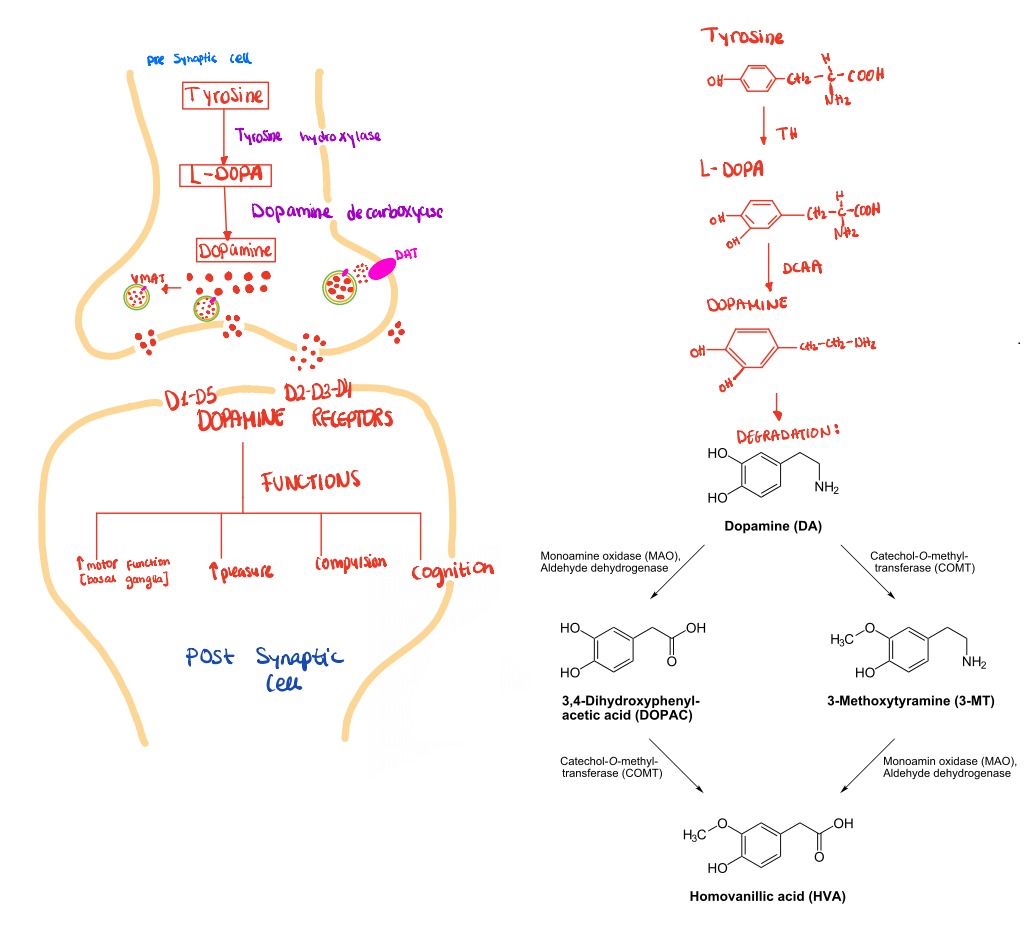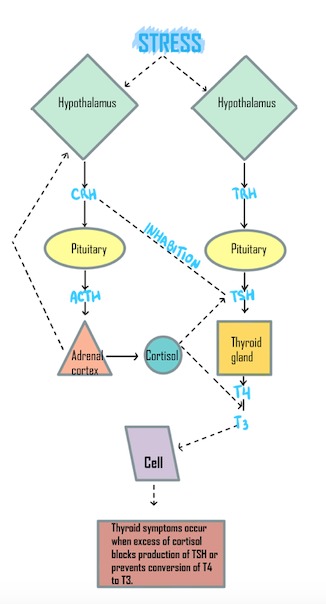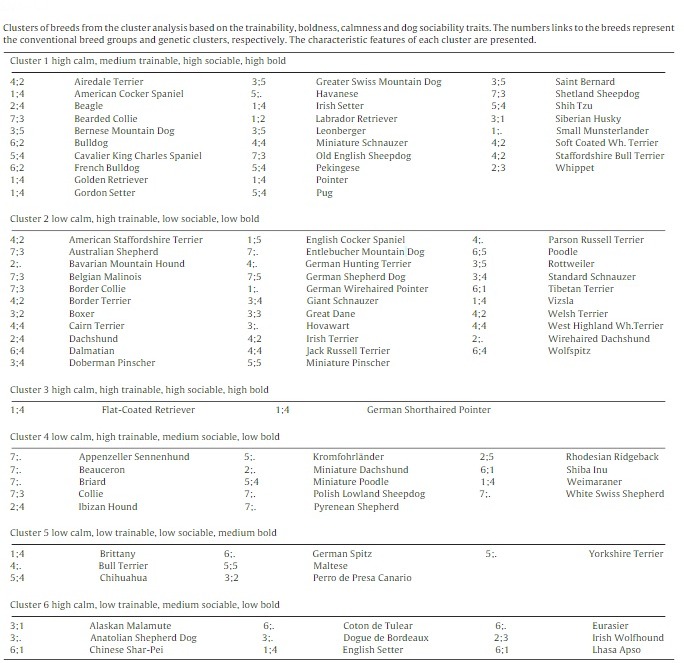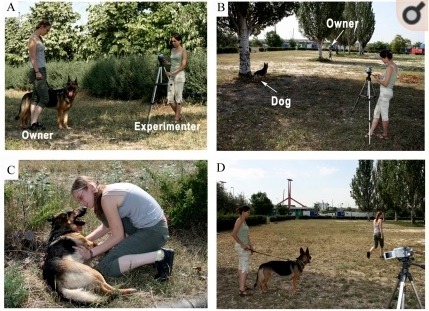|
Size: 36703
Comment:
|
Size: 36684
Comment:
|
| Deletions are marked like this. | Additions are marked like this. |
| Line 185: | Line 185: |
| ○ Brennen McKenzie, MA, MSc, VMD, cVMA. Pheromones’ therapeutic use in animals. March 14, 2018, https://www.veterinarypracticenews.com/pheromones-therapeutic-use-in-animals/ | ○ Brennen McKenzie, MA, MSc, VMD, cVMA.(2018): Pheromones’ therapeutic use in animals. https://www.veterinarypracticenews.com/pheromones-therapeutic-use-in-animals/ |
| Line 203: | Line 203: |
| ○ Nicholas Dodman- Dealing with Canine Hyperactivity. August 25, 2015; https://www.petplace.com/article/dogs/pet-behavior-training/hyperactivity-adhd-in-dogs/ | ○ Nicholas Dodman (2015): Dealing with Canine Hyperactivity. https://www.petplace.com/article/dogs/pet-behavior-training/hyperactivity-adhd-in-dogs/ |
ADHD Like Behavior in Dogs
Authors : Tali Muzykant Turchin, Linnéa Garrido-Andersson, Eden Fima
Supervisor : Dr. David Kiss
Physiology Department, University of Veterinary Medicine, Budapest
Attention deficit hyperactivity disorder (ADHD) is a neurodevelopmental type disorder which is characterized mainly in attention deficit, concentration difficulties, hyperactivity and impulsivity. The disorder is typically related to humans, but the signs can be manifested in dogs as well. Exactly like humans, dogs are social mammals. They share social qualities and keep social bonds. Moreover, there is a similarity between kids and dogs in the aspect of their association with social environments and their response to it. Those are the reasons for dogs suitability as modeling physiological diseases in humans.
Contents
Causes
Nowadays there is no absolute answer to what might cause ADHD, but it seems like an interaction between genetics, social behavior and physical condition.
Genetic
|
ADHD is a neurobiological disorder that is associated to dysfunctions of neurotransmitters. Genetic studies indicate that the disorder can be related to a polymorphism in tyrosine hydroxylase (TH) gene that directly affects the dopamine neurotransmission (Fig.1) and to a DRD4 gene polymorphism which is responsible for D4 dopamine receptor coding.
In a case study that has been performed by Ito et al. (2004), 23 breeds were divided based on their allele frequency. Dogs belonging to group A showed frequency in 435 and 447a alleles while the 447b, 498 and 549 were frequent in group B. The phenotype of the dog was analyzed by a questionnaire to the owner and it was possible to see that group B had a higher score in aggressiveness and a lower value of reactivity and trainability compared to group A. Another similar case study (Hejjas, 2007) was conducted but it focused on a single breed- German Shepherd dog. The results correlated with the Ito et al. (2004) study and showed that a frequency of specific and same alleles will result in ADHD like behavior traits such as social impulsivity, activity impulsivity and inattention.
Another theory that has been tested is a connection between tyrosine hydroxylase (TH) polymorphism and the activity impulsivity trait (Kubinyi et al., 2012). TH is a catalyzer of the conversion of the dopamine precursor (dihydroxyphenylalannin, DOPA), dopamine is the precursor of catecholamines epinephrine and norepinephrine. As neurotransmitters, dopamine and norepinephrine are involved in many physiological processes such as attention and focus, movement control, cognition and etc., so they may be implicated in ADHD. German Shepherd dogs were investigated for the effect of TH repeat polymorphism on the activity impulsivity trait that was determined earlier by an owner questionnaire and a behavior test. The results showed that the dog group, who possessed at least one short allele (instead of homozygotes with only longer allele) was previously reported as active and impulsive by their owner and the behavior test that can be shown inFig. 4.
Social and physical
|
In addition to genetic factors, physical and social factors seem to have an important effect on the ADHD like behavior in dogs. Hoppe et al. (2017) found a correlation between certain factors and their effect on ADHD like behavior based on different questionnaires.
• Inattention can be caused by lack or a small amount of affectional behavior after adoption and by the sleeping pattern of the dog (alone/ with owner/ with other pets).
• How fast the dog will gain or lose interest and other concentration problems with games or tasks may be affected by the number of social contacts the dog experienced (dog-dog or dog-human).
• Problems with keeping itself calm can indicate on a long lasting separation periods. Another study might support this claim- Weller and Fuller (1961) found out that puppies who were separated from other puppies and had only limited access to them, displayed an excessive activity in social situations.
• Motor activity - castrated dogs seems to present a significantly higher motor activity, the explanation for that was shown by Lisberg and Snowdon (2011) and Farhoody et al. (2018) and claims that dogs who have been castrated have an increased risk for development of fear, hyperactivity and anxiety duo to decrease in testosterone levels.
Hypothyroidism- since the human medicine shows correlation between a hypothyroid function and a wild range of behavioral symptoms, where aggression is one of them, L.P Aronson (2008) suggested to test this theory also on dogs. Of the 1500 dogs that shown behavioral problems, 61.4% suffered from low or sub-optimal thyroid function. 54% of the diagnosed dogs showed a significant relationship between hypo-function of the thyroid gland and aggression, both, to human and to other dogs. There is not a clear understanding about how low thyroid function may affect the behavior however it might be linked to the fact that low levels of thyroid hormones may affect the dog's hypothalamic-pituitary-adrenal axis which controls the reaction of the dog to stress. Moreover elevated levels of cortisol, that might be found in dogs, may cause it to feel a constant stress. High levels of cortisol will also suppress the production of thyroid stimulation hormone (TSH), reduce the conversion of T4 to T3 and have a direct effect on the thyroid gland itself. Therefore, the thyroid-adrenal axis (Fig.2) might affect the behavior.
Symptoms
ADHD in canines seems to be with similar pathology as in humans. Dogs with ADHD show several behavioral signs. They manifest spontaneous activity without any stimulation and they simply can't relax. In addition, they have an elevated body temperature, heart and respiratory rate which stay high while in rest and during an activity. Dogs with ADHD are more difficult to train since their attention span is decreased and they also show signs of aggressive behavior.
In addition to these factors there are other details to be considered, especially the breed of the dog. Different dog breeds have different genes, and these carry different behaviors which we need to consider whether they are normal or abnormal for the specific dog. For example – terriers naturally have high levels of energy, excitement and boldness and with certain environmental factors one may think that a dog may be hyperactive while he is just acting as he is supposed to. Four important traits relating to dog behavior are trainability, calmness, sociability and boldness. The amount of the trait that each dog expresses has a great dependence on the breed – herding dogs are more trainable than toy dogs and non-sporting dogs, terriers are bolder than hounds. Using these descriptions of traits for each dog breed, we can create breed clusters as Fig.3 shows and use them to group dogs together based on their typical behavior. Using these clusters, if a dog breed is known for a certain type of behavior, the traits it expresses can be somewhat predictable. This can help in noticing symptoms of ADHD since a dog owner can look for large discrepancies between how his dog behaves and what the dog breed usually behaves like. For example- if an Alaskan Malamute, which are usually calm and easy to train according to the cluster of breeds, is hyperactive and difficult to train, this might be an indication for an ADHD behavior. We can compare it to a Chihuahua that is naturally not calm and hard to train and doesn’t necessarily expresses ADHD symptoms, but just behaves normally.
|
Diagnosis
The main question that might be asked is how can we differentiate between a normal behavior of a dog to an ADHD-like behavior.
Pre-diagnosis by the owner
Behavioral phenotype identification is a complicated thing to do, but a pre-diagnosis by the owner is possible through different means. Owners can primarily lean on the ADHD-Rating Scale, generally established on the human one, showing if the animal has ADHD-like symptoms. High boldness, low trainability, low calmness and low sociability are the main ones. The questionnaire will start with basic information about the dog- breed, age, living area and etc. Later on specific questions regarding the inattention and hyperactivity- impulsivity will be asked:
► It’s easy to attract your dog’s attention, but your dog loses interest easily.
► Your dog barks endlessly, seemingly at nothing important.
► Even if your dog knows someone is speaking to him/her, your dog doesn’t seem to pay any attention.
► Your dog often has difficulties performing tasks, even if your dog has practiced them often.
► Your dog’s attention can be easily distracted.
► Your dog cannot wait as it has no self-control.
(Questions from the ADHD Rating Scale Du-Paul, (1998) and Vas et al. (2007), modified by Lisa et al. (2010) for American dog owners)
Owners can also base their research on their dog’s breed, as there is evidence to suggest that some breeds seem to be predisposed to ADHD. Regarding genetic relatedness, breeds with ancient Asian or African origin seem to be less trainable than other breed groups(Turcsán et al., 2011).
Diagnosis by a professional
|
In a study of the computational analysis of movement patterns of dogs with ADHD-like behaviors, 12 movement parameters were analyzed. This led to the identification of 3 dimensions after an observation of the most significant differences between the sample models : high speed, large coverage of the room space, and constant re-orientation in space, the 3 of them being easily observable by the clinicians.
Furthermore, examinations can be done, especially urine investigations, in order to notice the presence or not of the metabolites of serotonin, related to behavioral inhibition, and dopamine, related to behavioral activation. The link between the renal system and the central nervous system remains unclear, but it has been demonstrated that individuals with a higher level of impulsivity in the DIAS (Dog Impulsivity Assessment Scale) would demonstrate a lower level of those metabolites in the urine. Aggressive behavior, characteristics of ADHD in dogs, is also characterized by reduced monoaminergic levels in the cerebrospinal fluid. The detection of these metabolites in the urine represents a non-invasive alternative suitable for the veterinary practice. Finally, a test can also be realized by giving the dog methylphenidate or D-amphetamine under clinical control. If the heart rate, respiratory rate and general ADHD symptoms are reduced, the dog can be diagnosed with ADHD.
Management
Behavioural therapies
|
Figure 5: Impulse control. (YouTube video) |
Environmental factors for the brain together with triggering long- lasting behavioral changes are crucial. Therefore, it is important to provide them in several ways as prevention and support to the medicinal therapies. In those cases, communication between the trainer and the behavioral veterinarian are essential in order to build a suitable treatment protocol.
As Hoppe at el. study indicates, several factors can influence the dog behavior- thus, there are possible ways to manage and decrease the degree of the symptoms.
• Impulse control- teach the dog that calm and polite behavior (Fig.5) is more beneficial in terms of getting what they want. First step will be to determine what it is that the dog wants, and then build a substitute behavior to over-excitement by gradually rewarding the correct behavior. Most common example is hooking the leash before going out for a walk. Most dogs get excited and jumpy as soon they see the leash, however it cannot jump forever so wait until it will calm down. Eventually the dog will learn that only a calm sitting will get the leash and the walk, and behave accordingly.
• Exercise and training routine- physical exercises can be used to get your dog on a healthy routine of energy outlet in order to prevent unwanted behavior. Mental stimulation is also important and can be achieved with dog puzzles, clicker work, eating toys, training classes or agility.
• Increased socialization- expose the dog gradually to noises, smells and new environments so it won’t become anxious and fearful of anything unfamiliar which may lead to aggression, nervosity and other ADHD like behaviors.
Diet management
The intestinal content seems to have a major impact on the neurotransmitters production. In fact, a ketogenic medium chain triglyceride diet ( with high-fat, low-protein and low-carbohydrates contents) is able to reduce some symptoms that dogs with ADHD-like behaviors experience, like chasing, low trainability and stranger-directed fear factors, through described axiolytic and cognition-enhancing effects. The low-protein content specifically reduces different forms of aggression in dogs.
Medicinal management
• Methylphtalenes (Ritalin) is commonly prescribed to help calm dogs and curb obsessive behaviors. They block more than 50% of the dopamine transporters, but in therapeutic use they also increase the extracellular dopamine in the basal ganglia, which enhances task specific neuronal signaling, thus boosting attention and decreasing distractibility. If they’re not applied in the right amount and for an appropriate length of time, they might cause toxicosis.
• Dextroamphetamine is a non-catecholamine with CNS-stimuling effects, due to the release of norepinephrine and dopamine within the mesocorticolimbic system, which may be used as a treatment to ADHD-like behaviors in dogs. It’s especially affecting the heart rate by significantly decreasing it, as well as the behavior. Unfortunately, similar to other amphetamines, it has a high potential for dependence.
• Fluoxetine is a surrogate to methylphtalenes. If the behavioral management through an acute training of the dog is not enough to palliate to the ADHD symptoms, it becomes a key treatment when methylphtalenes are not legally authorized for veterinary use. Unlike methylphtalenes, the use of Fluoxetine has not been associated with long-term adverse effects.
|
Figure 6: CBD treatment(YouTube video) |
In recent years, some alternatives to these conventional treatments have emerged on the market.
• Depending on countries’ laws, CBD oil is frequently chosen as one of those substitutes, like seen inFig.6. Indeed, it’s acting on the Endocannabinoid system consisting of receptors for cannabinoids, naturally produced by the body. Psychoactive cannabinoids are substances increasing the activity of dopaminergic neurons in the ventral tegmental area-mesolimbic pathway in humans. Little is known about its mechanism in Canines.
• Pheromonatherapy is another option. Pheromones are naturally secreted and used for communication between individuals of the same species. Advertised as DAP, « Dog Appeasing Pheromones », they are a synthetic equivalent of the pheromone secreted by bitches to reassure their progenies, providing signals of security and comfort for dogs of any age. Recent findings showed that they molecularly activate several sensory neurons.
• St. John’s Wort is also used in ADHD treatments for dogs. In reality, this plant has an effect on the brain by inhibiting the reuptake of several neurotransmitters, including glutamate, serotonin, dopamine and norepinephrine ; as well as releasing glutamate from vagal afferents synapsing with the nucleus tractus solitarius of the brainstem ; resulting in an improvement of the overall attention of the animal for a certain period of time.
References
1. Ameri A. (1999): The effects of cannabinoids on the brain. Published on- Prog Neurobiol. 58(4):315-48. https://www.ncbi.nlm.nih.gov/pubmed/10368032/
2. Anneke E. Lisberga,b,*, Charles T. Snowdon (2011): The effects of sex, gonadectomy and status on investigation patterns of unfamiliarconspecific urine in domestic dogs, Canis familiaris. Published on- Animal Behaviour. Volume 81, Issue 4, Pages 757-764. https://doi.org/10.1016/j.anbehav.2011.01.006
3. Bakhtiar R1, Ramos L, Tse FL. (2004): Toxicokinetic assessment of methylphenidate (Ritalin) in a 13-week oral toxicity study in dogs. Published on- Biomed Chromatogr 18(1):45-50. https://www.ncbi.nlm.nih.gov/pubmed/14872548
4. Borbala Turcsan, Eniko Kubinyi, Adam Miklosi (2011): Trainability and bondless traits differ between dog breed clusters based on conventional breed categories and genetic relatedness. Published on- Applied Animal Behaviour Science 132(1):61-70 https://www.researchgate.net/publication/228485434_Trainability_and_boldness_traits_differ_between_dog_breed_clusters_based_on_conventional_breed_categories_and_genetic_relatedness
5. Enikő Kubinyi, 1 , * Judit Vas, 1 Krisztina Hejjas, 2 Zsolt Ronai, 2 Ildikó Brúder, 1 Borbála Turcsán, 1 Maria Sasvari-Szekely, 2 and Ádám Miklósi 1 (2012): Polymorphism in the Tyrosine Hydroxylase (TH) Gene Is Associated with Activity-Impulsivity in German Shepherd Dogs. Published on- PLOS ONE. https://doi.org/10.1371/journal.pone.0030271
6. Hannah F. Wright a,⁎, Daniel S. Mills a, Petra M.J. Pollux b (2012): Behavioural and physiological correlates of impulsivity in the domestic dog (Canis familiaris). Published on- Physiology & Behavior . Volume 105, Issue 3, 1 February 2012, Pages 676-682 https://www.sciencedirect.com/science/article/abs/pii/S0031938411004689
7. Hideyuki ITO, Hidetoshi NARA, Miho INOUE-MURAYAMA, Makoto K. SHIMADA, Akiko KOSHIMURA, Yuko UEDA, Hitoshi KITAGAWA, Yukari TAKEUCHI, Yuji MORI, Yuichi MURAYAMA, Mitsuo MORITA, Toshiroh IWASAKI, Katuaki ÔTA, Yuichi TANABE, Shin'ichi ITO (2004): Allele Frequency Distribution of the Canine Dopamine Receptor D4 Gene Exon III and I in 23 Breeds. Published on- journal of veterinary medical science, Volume 66 Issue 7 Pages 815-820 https://www.jstage.jst.go.jp/article/jvms/66/7/66_7_815/_article/-char/ja/
8. Judit Vas, József Topálb Éva Pécha Ádám Miklósia (2007): Measuring attention deficit and activity in dogs: A new application and validation of a human ADHD questionnaire. Published on- Applied Animal Behaviour Science. Volume 103, Issues 1–2, Pages 105-117, https://doi.org/10.1016/j.applanim.2006.03.017
9. K. Hejjas J. Vas J. Topal E. Szantai Z. Ronai A. Szekely E. Kubinyi Z. Horvath M. Sasvari‐Szekely A. Miklosi (2007): Association of polymorphisms in the dopamine D4 receptor gene and the activity‐impulsivity endophenotype in dogs. Published on- Animal Genetics, Volume 38, Issue 6 Pages: 539-666. https://doi.org/10.1111/j.1365-2052.2007.01657.x
10. Kogan L, Schoenfeld-Tacher R, Hellyer P and Rishniw M (2019): US Veterinarians' Knowledge, Experience, and Perception Regarding the Use of Cannabidiol for Canine Medical Conditions. Published on- Front. Vet. Sci. https://doi.org/10.3389/fvets.2018.00338
11. Lisa Stowers and Tsung-Han Kuo (2015): Mammalian pheromones; emerging properties and mechanisms of detection. Published on- Current Opinion in Neurobiology Volume 34, October 2015, Pages 103-109 https://doi.org/10.1016/j.conb.2015.02.005
12. Nikolai Hoppe, MSc, Olaf R. P. Bininda-Emonds, Prof., DPhil, Udo Gansloßer, Priv. Doz. Dr. Dr. habil (2017): Correlates of Attention Deficit Hyperactivity Disorder (ADHD)-Like Behavior in Domestic Dogs: First Results from a Questionnaire-Based Study. Published on- Open journal (openventio publisher), Volume 2 : Issue 3 Article Ref. #: 1000VMOJ2122. http://dx.doi.org/10.17140/VMOJ-2-122
13. Parvene Farhoody,1 Indika Mallawaarachchi,2 Patrick M. Tarwater,3 James A. Serpell,4 Deborah L. Duffy,5 and Chris Zink6,* (2018): Aggression toward Familiar People, Strangers, and Conspecifics in Gonadectomized and Intact Dogs. Published on- Front. Vet. Sci. https://doi.org/10.3389/fvets.2018.00018
14. Stiles, Enid & Palestrini, Clara & Beauchamp, Guy & Frank, Diane. (2011): Physiological and behavioral effects of dextroamphetamine on Beagle dogs. Published on- Journal of Veterinary Behavior Clinical Applications and Research 6(6):328-336 https://doi.org/10.1016/j.jveb.2011.03.001
15. Volkow ND, Fowler JS, Wang G, Ding Y, Gatley SJ (2002): Mechanism of action of methylphenidate: insights from PET imaging studies. Published on- Journal of Attention Disorders. Volume: 6 issue: 1_suppl, page(s): 31-43 https://doi.org/10.1177/070674370200601S05
Others (websites\ books\ YouTube videos)
○ Brennen McKenzie, MA, MSc, VMD, cVMA.(2018): Pheromones’ therapeutic use in animals. https://www.veterinarypracticenews.com/pheromones-therapeutic-use-in-animals/
○ https://www.youtube.com/watch?v=rQnIWkKJF1g
○ https://www.youtube.com/watch?v=RdbacbKtV0I
○ https://pethelpful.com/dogs/The-Link-Between-Hypothyroidism-and-Dog-Aggression
○ https://en.wikipedia.org/wiki/Attention_deficit_hyperactivity_disorder
○ https://www.whole-dog-journal.com/behavior/think-your-dog-has-adhd/
○ Linda P. Aronson and W. Jean Dodds (2008): The Effect of Hypothyroid Function on Canine Behavior. http://www.dogs4dogs.com/JR_Articles/dog-thyroid-and-behavior.htm
○ Methylphenidate use in dogs with attention deficit hyperactivity disorder (ADHD). A case report of a Weimaraner bitch https://www.researchgate.net/publication/261744134_Methylphenidate_use_in_dogs_with_attention_deficit_hyperactivity_disorder_ADHD_A_case_report_of_a_Weimaraner_bitch
○ Nicholas Dodman (2015): Dealing with Canine Hyperactivity. https://www.petplace.com/article/dogs/pet-behavior-training/hyperactivity-adhd-in-dogs/
○ The human as a model for Attention deficit hyperactivity disorder (ADHD) in domestic dogs (Canis familiaris) Kooij, L.(2012) (Master thesis) Faculty of Medicine Theses. https://dspace.library.uu.nl/handle/1874/225788
○ Whole Dog Journal Handbook of Dog and Puppy Care and Training By Nancy Kerns- https://books.google.hu/books?id=jfbnCwAAQBAJ&pg=PA133&lpg=PA133&dq=semi-isolation+exhibited+excessive+social+contact+behavior+when+given+limited+access+to+other+puppies.+When+kept+with+their+litters,+the+number+of+social+contacts+reduced+by+75+percent.&source=bl&ots=si923eXAJ4&sig=ACfU3U1Tw7vx6uXVJmM2v4SXqA6g706y7w&hl=en&sa=X&ved=2ahUKEwi1z6WM4oPpAhVpkIsKHRxhDQEQ6AEwCnoECAkQAQ#v=onepage&q=semi-isolation%20exhibited%20excessive%20social%20contact%20behavior%20when%20given%20limited%20access%20to%20other%20puppies.%20When%20kept%20with%20their%20litters%2C%20the%20number%20of%20social%20contacts%20reduced%20by%2075%20percent.&f=false
Figures
○ Fig. 1 Hand drawn figure by us (adopted from Smedlib, based on original work by Pancrat- https://en.wikipedia.org/wiki/Dopamine#/media/File:Dopaminergic_synapse.svg ) (Dopamine degradation part-https://commons.wikimedia.org/wiki/File:Dopamine_degradation.svg)
○ Fig. 2 Hand drawn figure by us (adopted from https://misaelrizo.weebly.com/acute-and-chronic-stress--feedback-loop.html )
○ Fig. 3 Taken from Turcsán et al. study case- Trainability and boldness traits differ between dog breed clustersbased on conventional breed categories and genetic relatedness (https://doi.org/10.1016/j.applanim.2011.03.006)
○ Fig. 4 Taken from Kubinyi et al. study case- Polymorphism in the Tyrosine Hydroxylase (TH) Gene Is Associated with Activity-Impulsivity in German Shepherd Dogs (https://doi.org/10.1371/journal.pone.0030271)
○ Fig. 5 Youtube video- Impulse control - teaching the dog calm and polite manners by Jennifer Cattet. https://www.youtube.com/watch?v=rQnIWkKJF1g
○ Fig. 6 Youtube video- Cannabis for canines: There's weed designed to relax anxious dogs by KHOU 11. https://www.youtube.com/watch?v=RdbacbKtV0I






